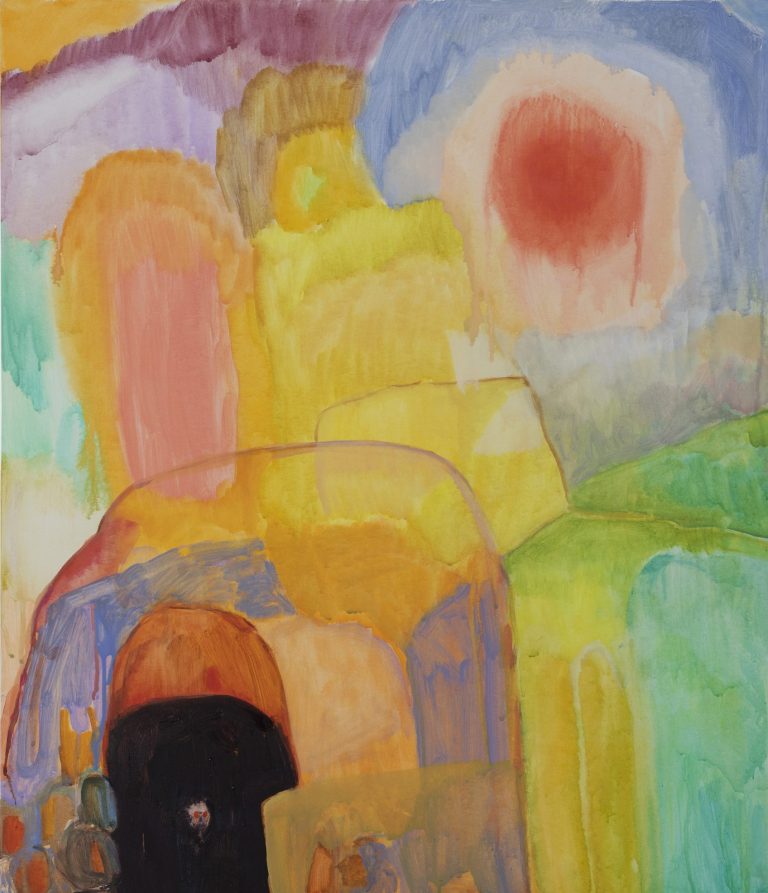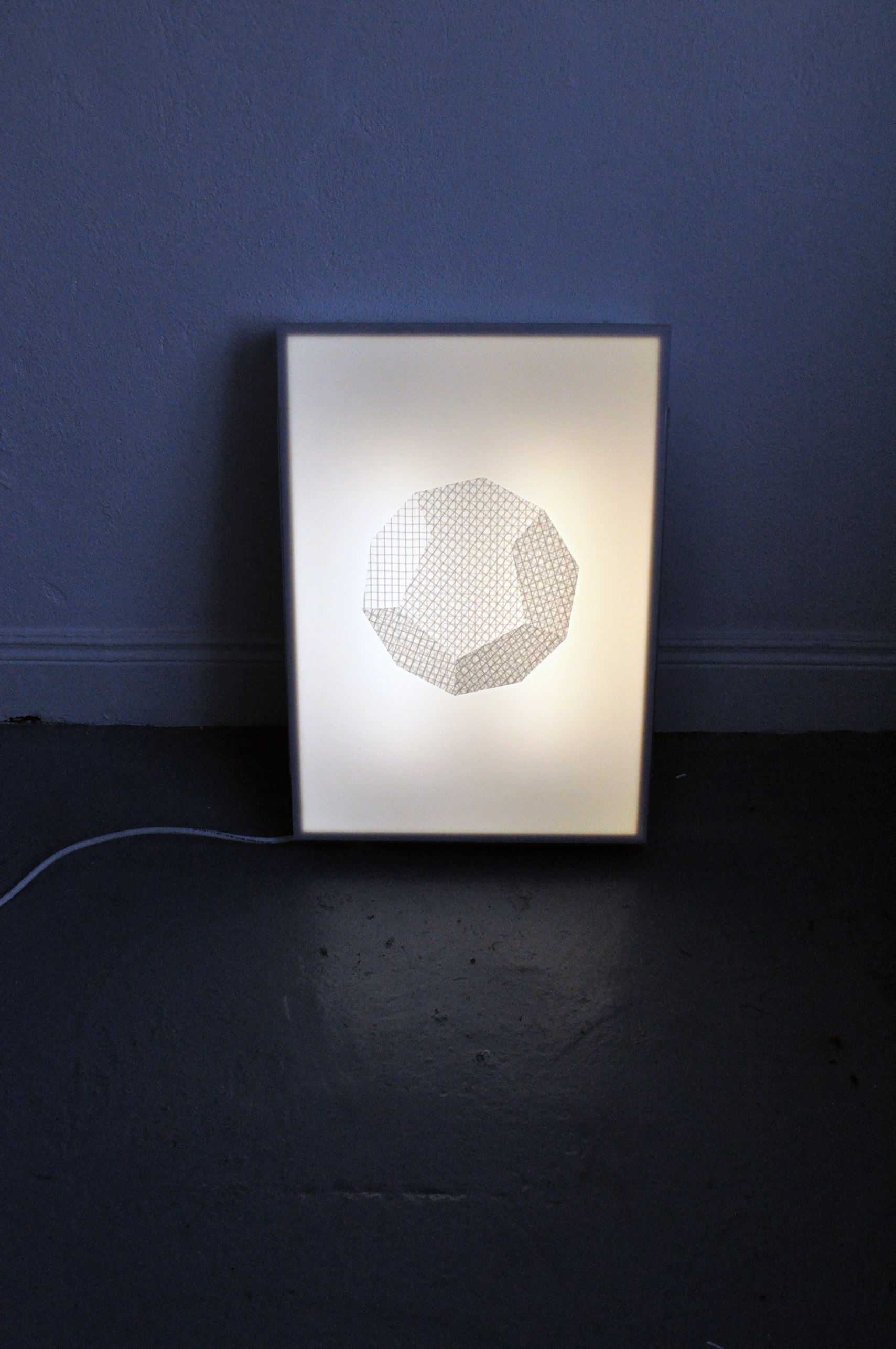Framing this exhibition at the Joinery is the debate surrounding the printed word, its value and its future. The invention of the printing press was as revolutionary as the internet, providing the means with which to disseminate information. Both the printed word and it’s new nemesis the internet have a shared association with elitism, knowledge, education and class. The first printing press with moveable type emerged in 1440, invented by the German Johannes Gutenberg. Its initial use was to mass produce ‘indulgences’ for the Catholic church (a type of remittance for sin purchased by the wealthy purporting to save them their punishments). Thereafter the products of the printing press were accessible only to those who were literate – read: relatively rich and of an educated class. So too is the internet. It would seem that the printed word and the digital word are equally (un) democratic, depending on how you look at it, or who you are.
The proposition in Paperplane, curated by Mary Conlon, is that digital information technology threatens the existence and the value of the printed word. Ironic then, that Apple launched it’s long awaited iPad the week before Paperplane opened. This seductive object is causing publishers everywhere to rethink the notion of what it is to read texts, how work will be disseminated, paid for and understood. All at a time when journals and magazines are faced with the choice of jettisoning print for online-only content – or face closure. These are choices I have seen played out first hand in my role at Circa Art Magazine. In Circa’s case, the survival of the print magazine is highly dubious, and in many other instances, print is also becoming an impossibility.
Italo Calvino’s Six Memos for the new millennium is a guideline for the values of literature, and the primary point of reference for this exhibition. It is a series of lectures written by Calvino for presentation at Harvard – though he died before he was able to present them. Tellingly, I was able to read this writing online, as a preview in Google books, and also as a PDF. There are six memos; Lightness, Quickness, Exactitude, Visibility, Multiplicity and the sixth that was not written on paper.
Lightness.
De Buitléar’s Fleet is a series of ‘video portraits’ of found objects; the video transforming the material into the temporal. The detritus of the printed world; bus tickets, brochures, call girls ads are all fashioned into the classroom pranksters’ weapon of choice, the paper plane. The noble beginnings of print are here reduced to a conflation of joke, junk, nuisance, throwaway and commercial objects. At great odds with Calvino’s high ideals for literature, these objects are purely functional, they advertise, they allow us on the bus, but they ruminate no further on their function or origins. De Buitléar imbues them with nobility through the use of portraiture, while simultaneously stripping them of their objecthood.
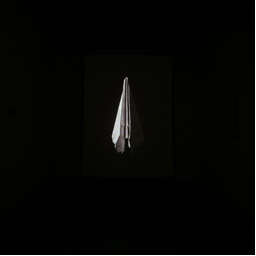 Niall de Buitléar, Fleet (detail), 2010, projection.
Niall de Buitléar, Fleet (detail), 2010, projection.
Quickness.
Vera Klute’s Swatter is a kinetic sculpture is constructed of 6 white fly swatters, attached to a mechanism that made them flap in synchronicity at what seemed like random intervals. This could be read as mimicry of the mechanised process of the printing press, but it is cumbersome and its movements shuddering and antiquated. In fact, while I was there, one of the swatters had detached itself from the machine.
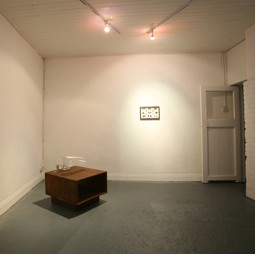 Vera Klute, Swatter, 2009, fly swatters, umbrella spokes, wood, motor, 70 x 70 x 70cm
Vera Klute, Swatter, 2009, fly swatters, umbrella spokes, wood, motor, 70 x 70 x 70cm
Exactitude
Swatter refers the viewer to the paper cut outs on the wall nearby, pinned to a mount like trapped insects. These paper cut outs bear an uncanny resemblance to Rorschach Inkblots. These were inscribed beneath with Latin terms, just like scientific classifications. Columbae in virgae sedet reads one of these; which, my online Latin to English translator tells me means ‘pigeon on a green twig’. These appear to direct the viewer to consider antiquity, classicism, science – and inevitably, the desire to preserve the dead and obsolete.
Visibility
Opposite from Klute’s work is a video diptych The Librarians, by the collective Guestroom. The eight video ‘portraits’ present librarians and their various reflections on books, literature and the value of printed matter. One interviewee states that he wants to see libraries where texts are ‘activated’: but later admits that he hates theatre. Another, Michael Leslie, is pictured playing his piano and speaks of the connections between music, literature and visual arts. His are almost the impressions of a synaesthesiac, he feels that Bach works in a 3 dimensional way, and sees Michaelangelo and Beethoven as ‘twin stars’. To him, the senses and the arts are all conflated in an overwhelming and compelling way.
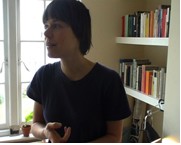
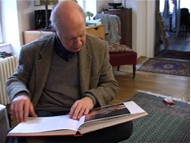
Guestroom: The Librarians, 8 video portraits.
Another presents a book dating from the 1500’s, documentation of a festival in France. He refers to book collectors having their fantasy league of books, but of the afore mentioned book he says ‘you cant do anything with it, it’s just an object.’ The overall impression from these vignettes of bookish types is that printed matter is reduced to being reserved for the obsessive collector, a fetishised object, an increasingly redundant pursuit, both bohemian and eccentric. The subjects themselves are pointedly aware of this, but as one states he just ‘can’t resist books.’
Multiplicity
In the front gallery are two works by Caline Aoun, both paper-based. Brighter beams is a series of unique inkjet prints mounted on cardboard tubes which look like mass produced packing tubes, only yellow. The point here is that these are in fact painstakingly handmade, something we are only aware of by reading the works title. Sliding Gazes is a series of ink jet prints on somerset paper, that appear to illustrate the four colour process of printing. Areas of colour are printed and overlaid one on the other, producing strange ghostly colour-field prints that end up somewhere between cobalt, black and purple. At the edges of each print, the printmakers’ obsession about ‘registration’ is deliberately overlooked. The edges of each colour are quite clearly visible, they don’t match up and are distinctly imperfect. The use of the ink-jet print is intriguing in this context, as its output is created digitally. For the first time in this exhibition the viewer sees the more practical contemporary relationship between print and the digital – that is, their co-dependency.
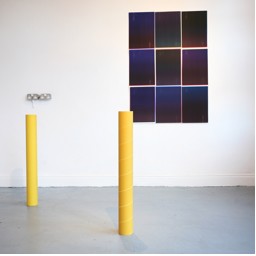 Caline Aoun, Sliding Gazes, 2009, Suite of unique inkjet prints on Somerset Paper, card, 138.9 x 97.8 cm and Brighter Beams, unique inkjet prints on paper, cardboard postal tube, dimensions variable.
Caline Aoun, Sliding Gazes, 2009, Suite of unique inkjet prints on Somerset Paper, card, 138.9 x 97.8 cm and Brighter Beams, unique inkjet prints on paper, cardboard postal tube, dimensions variable.
The sixth that was not written on paper
Paperplane illustrates print and literature as we know it as a medium on the precipice of change. Like so much technology and communication, it has the potential to become obsolete, replaced or superceded. However, as The Librarians so eruditely articulate, it is a testament to print’s enduring and seductive appeal that the book has prevailed this long in the face of the digital onslaught. It is too soon to know what the outcome will be for print, publishing and the humble book when faced with tablets e-readers and other devices as well as the internet. The works in this exhibition are collectively a compelling monument to the idea of print. They present both an homage and a series of possibilities which we will, undoubtedly, watch unfold.
Barbara Knezevic is an artist based in Dublin.


